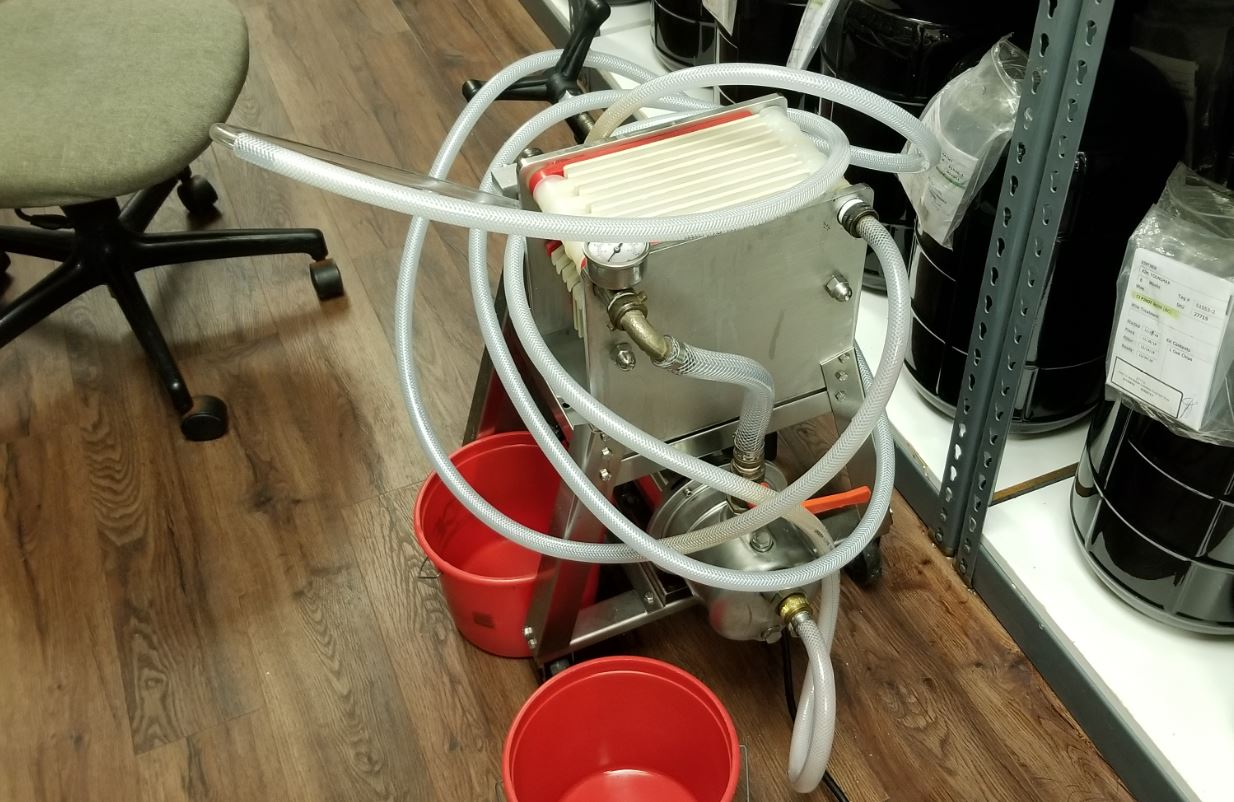
Filtering captures particles in your wine and it’s done 1-2 weeks after fining. Since fining, the wine has been sitting on the second shelf in the front row where we’ve been constantly watching as fermentation stops and clearing proceeds. We’re looking for signs that need attention to ensure this part of the process runs smoothly.
Staff Workout
Before filtering begins the staff get a workout, moving carboys from the second shelf to the lower shelf. Doing this 30 to 40 times is a workout! We place wines in reverse order of filtering with 4 in the back row and 4 in the front row. This makes sure the lighter wines are filtered first and the heavier wines last. Our new automated system makes sure we get it right. It reports the laydown order we need to follow for all wines due to be filtered. It eliminating guesswork so staff can focus on their workout.
Filtering
Filtering captures particles in your wine and setting up the filtering machine involves a lot of work. It’s followed by a repetitive process of running the wine from one carboy through the filtering machine and into another carboy. The last step is to thoroughly clean the filtering machine.
First, we soak the filter pads in water. While they’re soaking we run water through the pump and hoses by bypassing the filtering rack. Very carefully, we place filter pads in between the filter plates. The filter press is cranked to lock the pads in place, creating a sealed filter chamber. We attach the input syphon and the output flow tube in the proper places and we’re ready to filter.
During our filtering session, we’ll clean and reset the machine one or more times to change from fine to coarse filters. The laydown order is driven in part by the filter pad requirements so we can minimize the number of filter pads we use. This minimizes our impact on the environment. We compost used filter pads the same as we do kitchen waste.
The actual filtering is quite literally a sit down job. We use a small office chair on wheels so we can easily move between carboys as we move down the row. At this point we’ll add the recommended amount of sulphite. For customers that ask us not to add sulphite, this could impact the shelf life of their wine. I’m planning to blog on sulphites and other additives in the future. Spoiler Alert: Sulphites are probably not causing your headaches.
We carefully monitor the flow from one carboy to another, ensuring we pick up as little sediment from the bottom of the carboy as possible while we extract a minimum of 30 bottles or about 23 litres.
Cleaning
After all of the filtering is complete comes the recurring theme, the cleanup. First the filter chamber is dismantled and the pads are drained and removed for composting. The filtering machine is then flushed with fresh water until the output runs clear. Next we run a solution of sulphite and water through the machine, cycling for about 2 minutes. At the end of 2 minutes the system is drained and we manually wipe down the entire machine with a sulphite soaked rag. Hoses and filter machine are stored and then…..
Each carboy is rinsed thoroughly, then subjected to a Diversol bath (mild bleach solution). After the Diversol has completed its job of sterilizing the inside (about 3 minutes), the carboy is thoroughly rinsed and the outside is washed and rinsed by hand. The carboys are then dried and cooled before we put in fresh airlocks and store them on the shelves for rotation.
We’re careful to follow our rotation pattern in the back room ensuring the all of our vessels are fresh and clean.
Next Months topic Crafting Your Wine Step 5 – Bottling.
